Ledebouria minima
Ledebouria minima (Baker) S. Venter.
Family: Hyacinthaceae
Common names: dwarf African hyacinth
Introduction
A dwarf ledebouria, with erect to spreading, grass-like leaves and very small bulbs, usually locally abundant, where it occurs in moist soil in grassland; this species is one of the smallest of all the ledebourias.

Description
Description
Solitary to densely gregarious, deciduous, bulbous plant; bulbs small, pear-shaped to spherical, with dead bulb scales membranous and not persistent. Leaves are narrow and grass-like, between 25–65 mm long and 3–6 mm wide, green and usually unspotted.
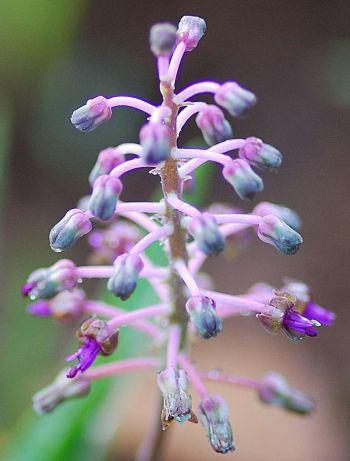
The flowers are borne in profusion, mainly in spring, on unbranched spikes, each bearing several, small, solitary, pink flowers, with strongly recurved tepals (petals), with protruding violet filaments (anther stalks), arranged loosely along the central peduncle (main stalk), each on a short, pale purple pedicel (flower stalk). Flowering takes place in spring and early summer (August to November), although flowers can be found sporadically until February. Very small, drop shaped seeds are produced following the flowers, in leathery, green capsules, which split open to release the shiny black and wrinkled seeds.
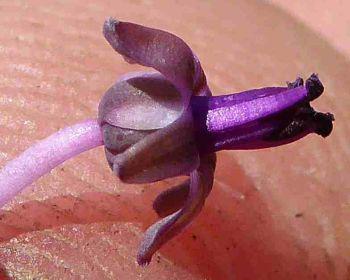
Conservation Status
Status
This species is widespread and very common where it occurs; it is not considered to be threatened in its natural habitat.
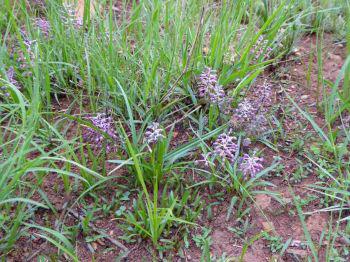
Distribution and habitat
Distribution description
The dwarf African hyacinth is distributed sparsely across South Africa, with the main centre of distribution in the Witwatersrand basin in Gauteng, where they occur in moist patches and seepages in grassland. The species is usually locally abundant, in full sun and mostly in short grassland.
Derivation of name and historical aspects
History
This species was first named as Scilla minima by J.G. Baker in 1870. It was subsequently transferred to the genus Ledebouria by S. Venter in 2008, in his taxonomic synopsis on the genus. Ledebouria is named in honour of the German-Estonian botanist, Professor Carl Friedrich von Ledebour (1785–1851). The specific name minima, is Latin and means smallest, presumably in reference to the small size of the plant, although it is not known exactly what was originally intended by Baker when he first applied that name.
South Africa has 39 species of Ledebouria. The genus is distributed across Africa, India and Madagascar with the centre of species diversity in the eastern parts of southern Africa.
Ledebouria minima is not easily confused with any other species of Ledebouria in the region, due to the small stature of the plants, usually less than 100 mm in height and with narrow, grass-like leaves which are usually difficult to find in their grassland habitat, unless they are in flower. Markings on the leaves are usually absent, however, the underside of the leaf bases are sometimes faintly spotted or banded with dark purple-green markings.

Ecology
Ecology
There is little documented information about the specific ecology of this species The dwarf stature and linear grass-like leaves may be useful to camouflage the plants among the grass to reduce the incidence of the leaves being targeted by herbivores. In the wild, the flowers, which are open, cup-shaped and unscented, suggest that they may be opportunistically pollinated by most visiting insects, most notably honey bees. The inflorescences are mostly erect; this may have something to do with optimizing visibility of the flowers amongst the grass for the pollinators. S. Venter (1993), suggested that the small, black seeds of Ledebouria minima may be distributed by water wash, which is likely after heavy thunderstorms, which are frequent across the areas where the species occurs.
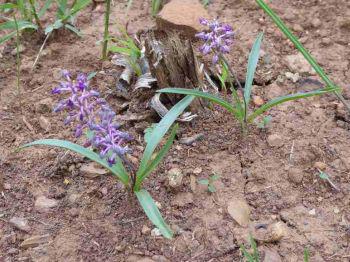
Uses
Use
There are no specific references in the literature indicating that Ledebouria minima has any uses by humans. The genus Ledebouria has been cited as having been used for medicinal purposes, including pregnancy, diarrhoea, influenza, backache, skin irritations, wound treatment, as well as lumbago. The genus is also reported as being poisonous, although it is also reported that bushmen eat the bulbs of certain species (L. apertiflora and L. revoluta). However, these may have been cooked or prepared in some manner to destroy the toxins, which is not specifically documented.
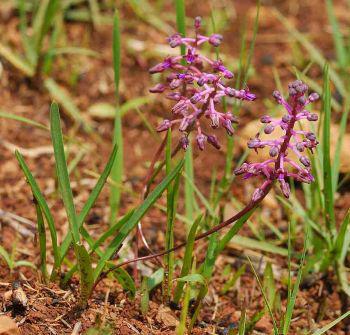
Growing Ledebouria minima
Grow
The dwarf African hyacinth is easily cultivated in the garden and is well suited to containers, due to its small size. Bulbs should be planted in a well-drained, organic-rich, loam soil. The addition of sifted kraal (cattle) manure and bone-meal is beneficial. Plants kept in containers need to be kept moist throughout the growing season. In their natural habitat they often experience waterlogging for prolonged periods where they occur, in shallow pans and seepage. They prefer a warm growing season, but can withstand very cold temperatures in winter, while the soil is completely dry and the plants are dormant. During the dry winter dormancy period, the pots should be moved out of the rain and placed in a dry, cool area with good air movement. Watering can commence at the onset of warmer weather (August to September in South Africa).
Propagation from seed is the best method of producing new plants. Seed must be sown fresh in spring or summer, in deep seed trays filled with the sifted potting mixture as detailed above. The seed can be sown on a firmly tamped surface and lightly covered with the same mixture, about 2 mm deep. The seed trays should be kept in a bright, warm position out of direct sunlight and kept damp for between 2 to 3 weeks, until germination has commenced. Once the seedlings have emerged, watering can be reduced. The seedlings can remain in the seedling tray for many years due to their small adult size, or be planted out at the beginning of their second or third growing season. Flowering size bulbs can be attained after 2 to 3 years.
References
- Jessop, J.P. 1970. Studies in the bulbous Liliaceae in South Africa: 1. Scilla, Schizocarpus and Ledebouria. Journal of South African Botany 36(4): 233–266.
- Venter, S. 2008. Synopsis of the genus Ledebouria Roth (Hyacinthaceae) in South Africa. Herbertia 62: page range?.
- Hankey, A. 07-2011. Ledebouria Roth (Hyacinthaceae). http://pza.sanbi.org/ledebouria-genus. Internet 5 pp.
- Dictionary of Botanical Epithets. Accessed 2016/09/27 http://www.winternet.com/~chuckg/dictionary.html
Credits
Andrew Hankey
Walter Sisulu National Botanical Garden
November 2016
Plant Attributes:
Plant Type: Bulb
SA Distribution: Eastern Cape, Free State, Gauteng, KwaZulu-Natal, Limpopo, Mpumalanga, North West, Northern Cape, Western Cape
Soil type: Clay, Loam
Flowering season: Spring, Early Summer
PH: Neutral
Flower colour: Purple, Pink
Aspect: Full Sun
Gardening skill: Easy
Special Features:
Horticultural zones











Rate this article
Article well written and informative
Rate this plant
Is this an interesting plant?
Login to add your Comment
Back to topNot registered yet? Click here to register.